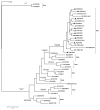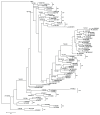Circulation of human respiratory syncytial virus strains among hospitalized children with acute lower respiratory infection in malaysia
- PMID: 23641140
- PMCID: PMC3629939
- DOI: 10.4137/EBO.S10999
Circulation of human respiratory syncytial virus strains among hospitalized children with acute lower respiratory infection in malaysia
Abstract
Human respiratory syncytial virus (RSV) is a major viral pathogen associated with acute lower respiratory tract infections (ALRTIs) among hospitalized children. In this study, the genetic diversity of the RSV strains was investigated among nasopharyngeal aspirates (NPA) taken from children less than 5 years of age hospitalized with ALRTIs in Hospital Serdang, Malaysia. A total of 165 NPA samples were tested for the presence of RSV and other respiratory viruses from June until December 2009. RSV was found positive in 83 (50%) of the samples using reverse transcription polymerase chain reaction (RT-PCR). Further classification of 67 RSV strains showed that subgroups A and B comprised 11/67 (16.4%) and 56/67 (83.6%) of the strains, respectively. The second hypervariable region at the carboxyl-terminal of the G gene was amplified and sequenced in order to do phylogenetic study. The phylogenetic relationships of the samples were determined separately for subgroups A and B using neighbor joining (NJ), maximum parsimony (MP), and Bayesian inference (BI). Phylogenetic analysis of the 32 sequenced samples showed that all 9 RSV-A strains were clustered within NA1 genotype while the remaining 23 strains of the RSV-B subgroup could be grouped into a clade consisted of strains with 60-nucleotide duplication region. They were further classified into newly discovered BA10 and BA9 genotypes. The present finding suggests the emergence of RSV genotypes of NA1 and BA. This is the first documentation of the phylogenetic relationship and genetic diversity of RSV strains among hospitalized children diagnosed with ALRTI in Serdang, Malaysia.
Keywords: Malaysia; acute lower respiratory tract infections (ALRTIs); human respiratory syncthial virus (RSV).
Figures




Similar articles
-
[Epidemiologic characteristics and the relationship with disease severity of respiratory syncytial virus genotypes from children with lower respiratory tract infection in the southern Zhejiang province].Zhonghua Er Ke Za Zhi. 2015 Jul;53(7):537-41. Zhonghua Er Ke Za Zhi. 2015. PMID: 26310648 Chinese.
-
Co-Circulation of 72bp Duplication Group A and 60bp Duplication Group B Respiratory Syncytial Virus (RSV) Strains in Riyadh, Saudi Arabia during 2014.PLoS One. 2016 Nov 11;11(11):e0166145. doi: 10.1371/journal.pone.0166145. eCollection 2016. PLoS One. 2016. PMID: 27835664 Free PMC article.
-
Respiratory syncytial virus subtype ON1/NA1/BA9 predominates in hospitalized children with lower respiratory tract infections.J Med Virol. 2017 Feb;89(2):213-221. doi: 10.1002/jmv.24619. Epub 2016 Jul 6. J Med Virol. 2017. PMID: 27358012 Free PMC article.
-
Genetic variability of respiratory syncytial viruses (RSV) prevalent in Southwestern China from 2006 to 2009: emergence of subgroup B and A RSV as dominant strains.J Clin Microbiol. 2010 Apr;48(4):1201-7. doi: 10.1128/JCM.02258-09. Epub 2010 Feb 10. J Clin Microbiol. 2010. PMID: 20147636 Free PMC article.
-
Respiratory syncytial virus genotypes NA1, ON1, and BA9 are prevalent in Thailand, 2012-2015.PeerJ. 2017 Oct 27;5:e3970. doi: 10.7717/peerj.3970. eCollection 2017. PeerJ. 2017. PMID: 29085762 Free PMC article.
Cited by
-
Molecular Evolution of Attachment Glycoprotein (G) and Fusion Protein (F) Genes of Respiratory Syncytial Virus ON1 and BA9 Strains in Xiamen, China.Microbiol Spectr. 2022 Apr 27;10(2):e0208321. doi: 10.1128/spectrum.02083-21. Epub 2022 Mar 21. Microbiol Spectr. 2022. PMID: 35311585 Free PMC article.
-
A multi-center study on Molecular Epidemiology of Human Respiratory Syncytial Virus from Children with Acute Lower Respiratory Tract Infections in the Mainland of China between 2015 and 2019.Virol Sin. 2021 Dec;36(6):1475-1483. doi: 10.1007/s12250-021-00430-7. Epub 2021 Aug 16. Virol Sin. 2021. PMID: 34398429 Free PMC article.
-
Viral etiology and seasonality of influenza-like illness in Gabon, March 2010 to June 2011.BMC Infect Dis. 2014 Jul 7;14:373. doi: 10.1186/1471-2334-14-373. BMC Infect Dis. 2014. PMID: 25000832 Free PMC article.
-
Immune Prophylaxis Targeting the Respiratory Syncytial Virus (RSV) G Protein.Viruses. 2023 Apr 27;15(5):1067. doi: 10.3390/v15051067. Viruses. 2023. PMID: 37243153 Free PMC article.
-
[Analysis of coinfections detected among respiratory syncytial virus subtypes and other respiratory viruses].An Pediatr (Barc). 2015 May;82(5):e255-6. doi: 10.1016/j.anpedi.2014.07.019. Epub 2014 Sep 7. An Pediatr (Barc). 2015. PMID: 25205177 Free PMC article. Spanish. No abstract available.
References
-
- Richard N, Komurian-Pradel F, Javouhey E, et al. The impact of dual viral infection in infants admitted to a pediatric intensive care unit associated with severe bronchiolitis. Pediatr Infect Dis J. 2008;27:213–7. - PubMed
-
- Weber M, Hartley J, Ashworth M, Malone M, Sebire N. Virological investigations in sudden unexpected deaths in infancy (SUDI) Forensic Sci Med Pathol. 1998;6:261–7. - PubMed
-
- Peter LC. Respiratory Syncytial Virus and Metapneumovirus. In: Knipe DM, editor. Fields Virology. 5th ed. Vol. 1. Philadelphia, PA: Lippincott Williams & Wilkins; 2007. pp. 1603–45.
LinkOut - more resources
Full Text Sources
Other Literature Sources

